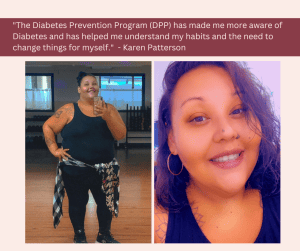By Michelle Jenck, M Ed.
October was Emergency Preparedness Month. It was a reminder that we can be caught off guard at any moment and that negative consequences of the unexpected can be greatly reduced if we take advance action to prevent the worst from happening.
Our most recent emergency was the covid-19 pandemic. As we rebuild after that event, it is important to consider what we learned and to apply that knowledge to avoid further devasting outcomes. We learned during the covid-19 pandemic is that individuals with chronic diseases like type 2 diabetes were at far greater risk of severe illness and death.
November is Diabetes Awareness Month. Type 2 Diabetes is occurring with far more frequency than earthquakes or hurricanes. We know what we need to do to prepare for and prevent its onset but we are not taking action in time to prevent it. We can screen for both type 2 diabetes and prediabetes. If we identify the condition at the prediabetes stage, there is much a person can do to reduce the likelihood of developing type 2 diabetes.
A simple blood test conducted by your medical provider is all that is needed. An A1C between 5.7 and 6.4 indicates a person is prediabetic. It is at this stage the condition is considered reversible. This blood test is part of an annual exam or well check. We owe it to ourselves and our loved ones to go in
for those yearly checkups. Just like we take our cars in to have the oil changed, tires rotated and balanced, we need to have the same level of care and concern to keep our bodies in good working order. It’s preventive maintenance and it saves us a lot of money and frustration down the road. Just
like avoiding maintenance of our car or home, the minor inconvenience of a doctor’s visit is minimal compared to the costs of delayed maintenance.
If we discover we are in that prediabetes range, the course of action is simple but not always easy.
Monitoring lifestyle habits like sleep, water intake, nutrition, and physical activity and making small changes (or perhaps large changes) will significantly reduce risk for developing type 2 diabetes.
These changes will also reduce risk for heart disease, stroke and cancer. Making these changes improves our mood, energy and overall quality of life. Once we begin feeling better, we become more motivated to stick with our new habits.
Read below a recent interview with Karen Patterson who is currently in the National DPP, she tells us how she lost 50 pounds in the first 16 weeks!
Karen Patterson, 36 years old, two daughters, lived in PNW her whole life, moved to the Oregon Coast last year and is getting started on a health and wellness journey. These are her thoughts on our program.

“The Diabetes Prevention Program (DPP) has made me more aware of Diabetes and has helped me understand my habits and the need to change things for myself.”
“I liked learning from everybody else that was pre-diabetic in class. I thought it was a good way of
getting to know people in your community. Everybody struggles, and on the days where I felt like I was struggling the most, and felt bad about it, I didn’t feel alone because it wasn’t just me in class (DPP). I loved getting to know everyone!”
“I loved meeting week after week, and the material was great. The fitness bands and the calorie book were fun things to get out of class. I would definitely recommend this class (DPP) because I think it is a step in getting to know what could be in your future if you are somebody who is pre-diabetic. I think it’s great for anyone to have the opportunity to do it (DPP). I like working out now, and I like eating healthier. It was a great class, I loved it!”
If making these changes feels overwhelming, consider joining the National Diabetes Prevention Program at the YMCA. If you’d like more information contact Kelly Benson at 503-842-9622 ext. 111 or kbenson@tillamookymca.org.
For more local health and wellness information, visit www.tillamookcountywellness.org or follow Tillamook County Wellness on Facebook, Instagram and Twitter.


